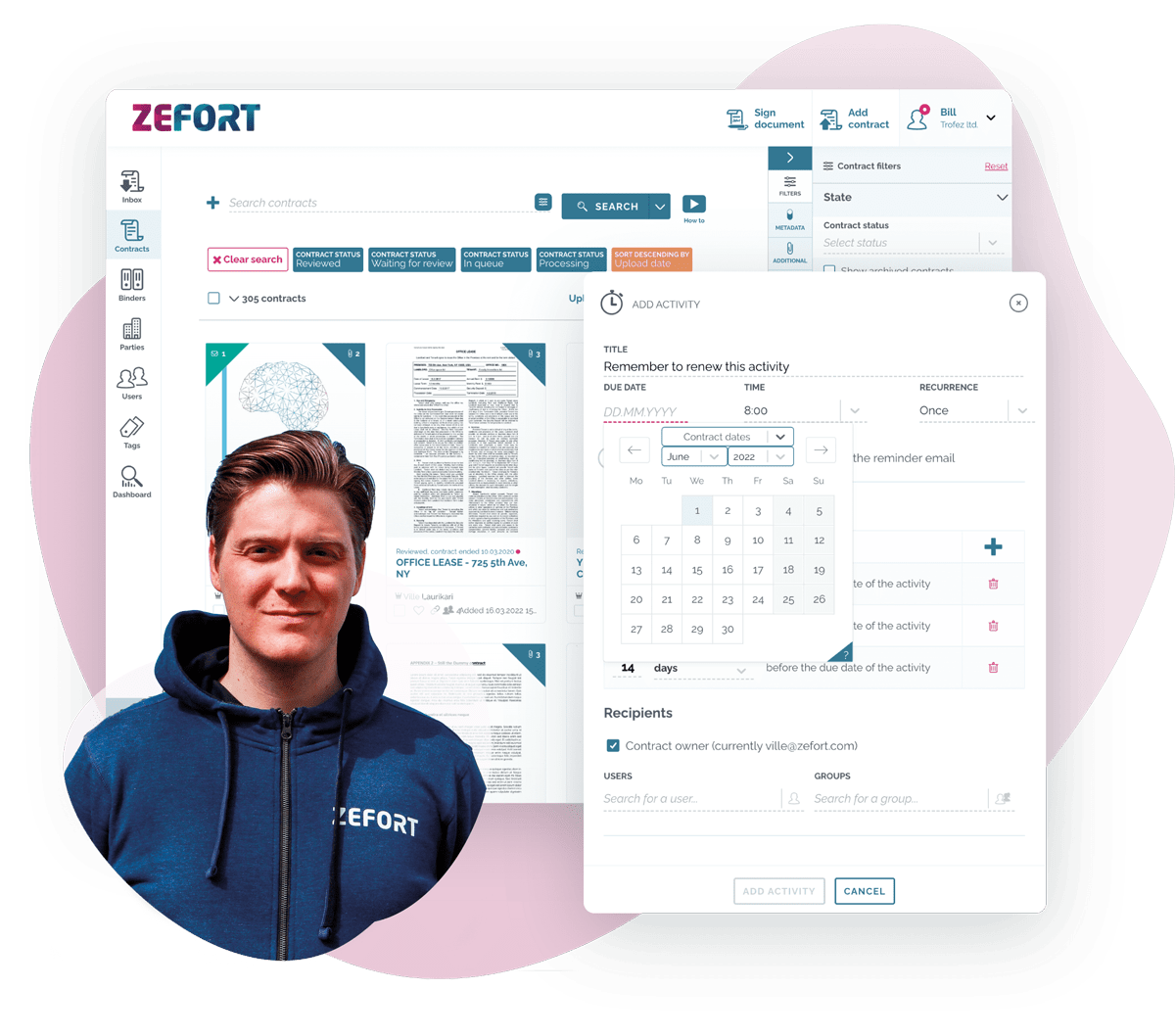In today’s fast-paced business world, contracts are the backbone of successful organizations. From vendor agreements to customer contracts, these legal documents govern relationships, transactions, and obligations. However, managing contracts efficiently can be a daunting task, especially when faced with mounting paperwork, multiple stakeholders, and ever-changing regulations. This is where Contract Lifecycle Management (CLM) comes in as a game-changer.
By streamlining the entire contract journey, CLM brings a breath of fresh air to businesses, empowering them to leverage their legal agreements for maximum advantage.
In this article, we will dive into the advantages of implementing Contract Lifecycle Management and how it revolutionizes the way companies handle their contracts. So, grab a cup of coffee and let’s explore the fascinating world of CLM!
Definition of Contract Lifecycle Management (CLM)
Contract Lifecycle Management refers to the process of managing contracts from initiation to execution and beyond. It involves the centralization and automation of contract-related tasks, such as drafting, negotiation, approval, and renewal. CLM helps organizations streamline their contract management processes, increase efficiency, reduce risks, and improve compliance.
By providing a centralized repository for contracts, CLM enables easy access to important information, facilitates effective contract monitoring, and enhances collaboration among internal and external stakeholders. Furthermore, CLM systems offer functionalities such as contract templates, version control, and automated alerts, which simplify the contract lifecycle and enable organizations to better manage their contracts.
Importance of CLM in Business Operations
Contract Lifecycle Management plays a vital role in streamlining business operations. It allows businesses to efficiently manage their contract processes from initiation to renewal or termination. With CLM, organizations can proactively monitor contract deadlines and compliance, reducing the risk of missed opportunities or costly penalties. By digitizing and centralizing contracts, CLM ensures easy access to critical information, enabling better decision-making and negotiation.
Contract Lifecycle Management Advantages
Enhanced Contract Visibility and Control
Enhanced contract visibility and control allows organizations to have a clear understanding of their contractual commitments, deadlines, and obligations. With improved visibility, businesses can easily track contract progress, monitor key milestones, and take timely actions to prevent potential risks or breaches.
By having greater control over contracts, organizations can streamline their workflows, improve compliance, and ensure efficient contract execution.
For example, with enhanced contract visibility and control, businesses can easily identify contracts that are up for renewal and initiate the necessary negotiations well in advance, avoiding last-minute struggles or missed opportunities.
Real-time Contract Tracking and Monitoring
Real-time contract tracking and monitoring enables businesses to stay updated on the progress and performance of their contracts in real-time, ensuring that they are on track and meeting their objectives. With advanced software and tools, companies can set up automated alerts and notifications for important contract events, such as renewal dates or milestones.
This enables them to take proactive actions, such as renegotiating terms or initiating contract termination, if necessary.
Improved Contract Compliance
With CLM, organizations can easily track and monitor contract terms, ensuring they are adhered to throughout the contract lifecycle. This reduces the risk of non-compliance and potential legal disputes.
For example, automated reminders can be set to prompt contract parties about upcoming renewal deadlines, reducing the chance of missed deadlines and contract lapses.
Additionally, CLM systems enable real-time visibility into contract performance, allowing organizations to identify and address any deviations from agreed-upon terms promptly.
Automated Compliance Management
Automated compliance management simplifies the process of ensuring adherence to legal and regulatory requirements, reducing human error and saving time. By automating compliance checks, organizations can minimize the risk of contract breaches and penalties.
For example, automated systems can flag inconsistencies in contracts or track expiration dates to avoid missed renewals. This not only maintains legal compliance but also streamlines the overall contract management process. Incorporating automated compliance management into contract lifecycle management gives businesses the confidence that they are operating within the bounds of relevant laws and regulations.
Streamlined Contract Creation and Negotiation
Streamlined contract creation and negotiation is a significant advantage of contract lifecycle management. It allows organizations to save time and resources by automating and simplifying the entire process. For instance, a robust contract management system can generate contracts using pre-approved templates, reducing manual effort and ensuring consistency.
Additionally, it enables seamless collaboration between multiple stakeholders, facilitating faster negotiations and eliminating version control issues. By streamlining contract creation and negotiation, organizations can accelerate deal closures, minimize errors, and improve overall efficiency.
Efficient Document Assembly and Template Management
By streamlining the document creation process and managing templates effectively, organizations can save time and improve accuracy.
With the help of advanced technology, contract management solutions enable users to easily assemble documents by selecting pre-approved clauses and templates. This eliminates the need to start from scratch each time, ensuring consistency and reducing errors. Furthermore, these solutions allow for templates to be easily updated and maintained, ensuring compliance with regulatory changes or internal policies.
Efficient Contract Execution and Approval
Efficient contract execution and approval enables organizations to streamline processes, minimize delays, and ensure compliance. By implementing an automated workflow system, contracts can be routed to the appropriate stakeholders for review and approval in a timely manner. This reduces the risk of bottlenecks and enables faster contract execution.
Additionally, using electronic signatures eliminates the need for manual signing, saving time and effort. Efficient contract execution and approval also provides visibility into the status of contracts, allowing organizations to track progress and make informed decisions.
Automated Workflow and Approval Processes
Automated workflow and approval processes streamline the contract lifecycle management process, enhancing efficiency and reducing manual errors. By automating repetitive tasks like gathering approvals and sending notifications, organizations can accelerate the contract approval process and ensure timely execution.
For example, an automated workflow allows contracts to be routed to the appropriate stakeholders for approval based on predefined rules, eliminating the need for manual handoffs. This reduces bottlenecks and ensures that contracts move through the approval process smoothly. Furthermore, automated approval processes provide visibility into the status of contracts, allowing stakeholders to track progress and take necessary actions where needed.
Optimized Contract Renewal and Termination
Optimizing contract renewal and termination is instrumental for effective contract lifecycle management. It allows businesses to streamline operations, mitigate risks, and maximize value. By leveraging data analytics, organizations can identify patterns and trends that enable better decision-making during the renewal or termination process.
For example, analyzing contract performance can reveal opportunities for renegotiation or early termination to improve cost efficiency.
Additionally, implementing automated notifications and workflows ensures timely renewal or termination actions, avoiding unnecessary delays or contract lapses. By focusing on optimization, companies can enhance contract management practices and achieve better outcomes throughout the contract lifecycle.
Proactive Notification and Reminder Systems
Proactive notification and reminder systems are valuable tools in contract lifecycle management. They enhance efficiency and accuracy by keeping stakeholders informed about crucial milestones, deadlines, and upcoming tasks. By sending automatic notifications via email or mobile applications, these systems ensure everyone is aware of their responsibilities and can plan accordingly.
For example, a vendor can be reminded to submit necessary documents before a specific deadline, and a manager can receive a notification when a contract is nearing its expiration date. This proactive approach reduces the risk of missed deadlines and enables timely actions to be taken.
Implementation of Contract Lifecycle Management
Implementation of contract lifecycle management involves the systematic management of contracts throughout their entire lifecycle. This includes processes such as contract creation, negotiation, approval, and renewal. By implementing contract lifecycle management, organizations can streamline their contract management processes, reduce risks, improve compliance, and enhance operational efficiency.
For example, it allows companies to easily track contract milestones, automate contract approval workflows, and improve contract visibility. This not only saves time and effort but also helps in making informed decisions and mitigating potential legal and financial risks.
Beneficial Results and Impact on Operations
Contract lifecycle management brings forth beneficial results and has a significant impact on operations. By effectively managing contracts throughout their lifecycle, organizations can streamline processes, reduce risks, and improve compliance. CLM enables centralized access and control over contracts, facilitating increased transparency, efficiency, and collaboration within teams. It eliminates manual tasks and supports automation, saving time and reducing errors.
Furthermore, CLM helps in identifying opportunities for cost-saving, mitigating supplier risks, and enhancing vendor performance.





